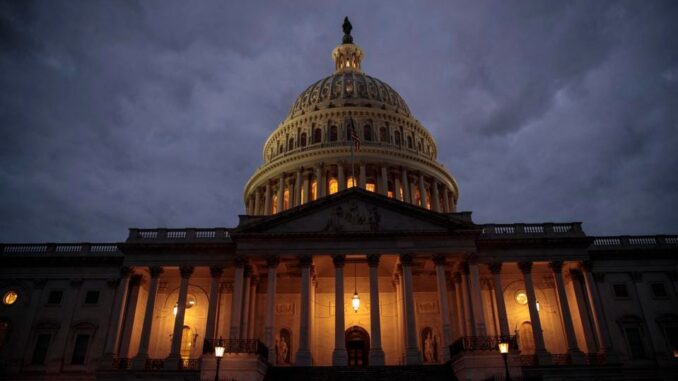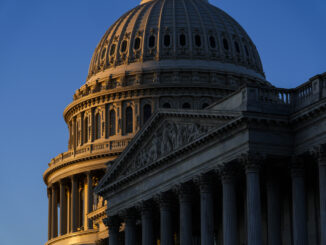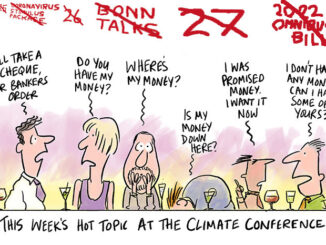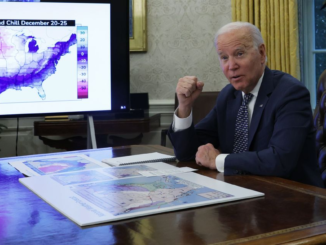
Key Take
- The $1.7 trillion government spending bill has passed, which means they’ll be able to keep the lights on until at least September next year.
- With over 4,000 pages worth of legislation, it’s not the type of thing that can be summarized easily. With that said, we’ve pulled out some of the key areas from the bill.
- Military and environmental spending are continued themes, as well as funds to prevent homelessness and help low income households with their children.
It’s that time again. The government’s budget was about to run out and they needed to get the sign off from the boss to keep it running. It sounds dramatic, but the truth is that this happens every year, and we weren’t expecting any major problems with getting it passed.
They’ve not always managed to get it done though – government shutdowns over a budget stalemate have happened before. The most recent shutdown happened in 2018/2019, due to disagreements over the funding of President Trump’s Mexico border wall.
There’s nothing quite as controversial in this year’s funding bill, but even so there’s plenty of debate over what’s going to go in and what’s been left out.
But what exactly are they planning on spending $1.7 trillion on, and how can investors take advantage of this massive level of government funding to potentially boost their portfolios?
Download Q.ai today for access to AI-powered investment strategies.
The details of the $1.7 trillion spending bill
This is a big document. Like, over 4,000 pages big. That might sound a bit OTT but keep in mind that it’s designed to cover all of the operating expenses for the Federal government, all the way through to September.
As a result, it needs to cover a lot of ground.
On top of the regular expenditure items, like making sure Park Rangers get paid and keeping the coffee stocked at the FBI headquarters, there are a large number of new or one-off funding arrangements included in the bill, such as:
Military and veterans spending
Military spending is a big theme in the bill.
Troops are getting a 4.6% pay raise and the VA medical care budget is being boosted by 22.4%. It will help cover cost increases due to higher inflation, and provide wider access to medical and housing services for veterans and their families.
It’s not just past military personnel who are going to benefit. There are billions for new Navy ships and F-35 fighter jets, as well as a massive $27.9 billion to help provide defense support to Ukraine.
Childcare funding for low income families
The Child Care and Development Block is receiving a 30% funding bump, worth around $8 billion, and Head Start will be getting an 8.6% increase worth $12 billion. These programs help low income families access childcare and helps them prepare for school.
Changes to retirement regulations
The bill contains a number of proposed changes to the rules around retirement and 401(k) plans. These include the need for auto-enrollment, meaning most employers will have to pay into a workplace retirement plan for their staff, which is currently optional.
It would also see the minimum age for mandatory withdrawals raised from 72 to 75 over time, increase the catch up contribution limits for employees over 60 and make the Savers Credit more attractive.
Assistance with utility bills
Energy bills have been going up, and the funding bill would provide some relief for low income households. The Low Income Home Energy Assistance program will provide a total of $6 billion to help lower income households cover the costs of heating and cooling.
Additional funding for assistance for the homeless and affordable housing
There will be a 13% increase in homeless assistance grants under the bill, equating to an additional $3.6 billion in funding. It’s estimated that this will help over 1 million people.
There will also be $6.4 billion allocation to community development programs, which will help economic growth in low and middle income neighborhoods. An additional $1.5 billion will be directed to the HOME Investment Partnerships Program, aiding construction of up to 10,000 new housing units.
Increased funding for the environment
The Environmental Protection Agency (EPA) will be receiving an extra $576 million under the bill, taking their total funding up to $10.1 billion. It’s a sizable increase that will allow the agency to put greater focus into the enforcement of regulations around clean water and air and appropriate management of hazardous waste products.
The National Park Service will also receive a funding boost, picking up a 6.4% increase. It also includes 14% additional funding for wildland firefighting.
There are also over 1,000 ‘earmarks’ for smaller projects within various energy and environmental agencies. These include things like $10 million for Kansas City to replace water lines and another $14 million for a water pump station in Springfield, Mo.
What’s not in the bill
Just as notable as what’s been included in the bill is what’s been left out. There are some notable legislation that’s been excluded, with some fairly high profile pieces that lawmakers have made numerous attempts to get through.
SAFE Banking Act
The biggest omission from the bill is the SAFE Banking Act, which is designed to allow cannabis related businesses to gain access to banking services. This was the third attempt at passing the bill and the second as part of a wider piece of legislation.
At the moment, cannabis businesses are in an awkward spot. It’s legal on some level in 37 states (and counting), and the rollout of easing rules continues at pace across the country. Even so, it’s still illegal at a federal level.
This makes it nigh on impossible for the businesses involved in it to gain access to traditional banks, forcing them to rely heavily on cash. Obviously this causes a range of account keeping and security issues.
The Act is designed to create an exemption to allow them access to banking services, but cannabis opponents have managed to scupper the legislation multiple times.
FBI headquarters
Lawmakers also couldn’t agree on where to put the new FBI headquarters, currently situated in Washington, D.C. There has been a push from representatives from neighboring Maryland to have the buildings moved there, and Virginia have thrown their hat in the ring as well.
It’s been agreed that a separate consultation and reporting process will be undertaken to sort this one out.
How investors can benefit from the spending bill
One of the biggest themes we’re continuing to see in the Biden administration is higher levels of spending on energy and the environment. Last year’s Infrastructure Spending Bill saw $50 billion being allocated to help fight climate change, and further funds have been provided this year.
On top of the continuation of the policies announced in that and other bills, this legislation adds further resources to the agencies in charge, such as the EPA and Parks Service.
This is good news for companies that operate in this sector. In our Clean Tech Kit, we use the power of AI to invest in companies that are in the business of renewable resources and energy.
They’re likely to be beneficiaries of this legislation, with bigger budgets providing a larger pie for them to generate revenue from. Within this Kit we invest in companies in a wide range of different sub-sectors, including renewable energy, lithium mining (for batteries), electric vehicles, waste reduction and recycling, hydrogen smart cell technology and smart water and waste-water technologies.
Every week our AI analyzes huge amounts of data and provides predictions on how the investment universe of ETFs and individual securities are likely to perform on a risk-adjusted basis.
It then automatically rebalances the Clean Tech Kit based on those predictions. So if you’re looking to invest in the green future, but not sure where to start, let our AI help you out.



